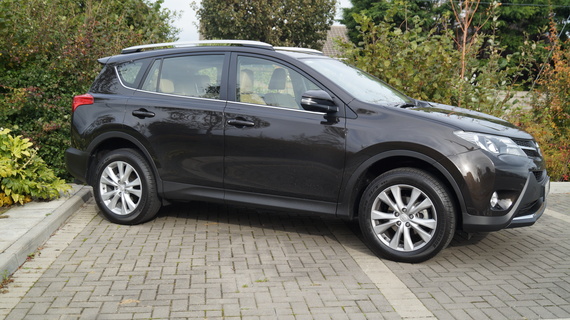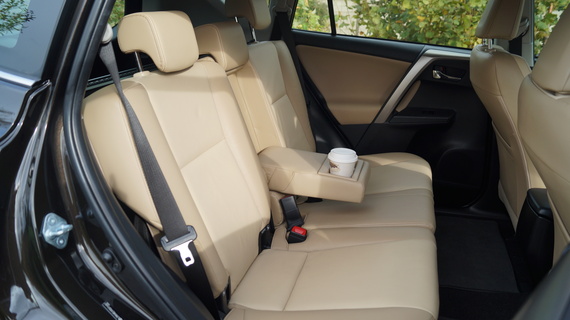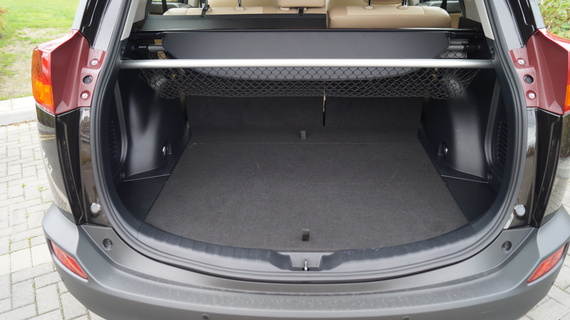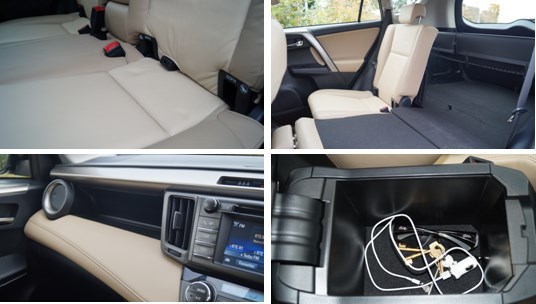 The Toyota RAV4, like us Irish in recent years, has had to make a few cutbacks. During the 2000’s it consumed a bit too much (fuel, that is) and it wasn’t cheap. Now though, the RAV4 is a reformed character with a new found focus on value for money. The latest model is as fuel efficient as the average family hatchback, has many more extras as standard. It genuinely offers more for less as it is in the region of €3,000 cheaper than before. It is also about 5% longer, so there’s more space inside. So where’s the catch? We wondered that too, so we arranged a test drive to check the RAV4 out.
The Toyota RAV4, like us Irish in recent years, has had to make a few cutbacks. During the 2000’s it consumed a bit too much (fuel, that is) and it wasn’t cheap. Now though, the RAV4 is a reformed character with a new found focus on value for money. The latest model is as fuel efficient as the average family hatchback, has many more extras as standard. It genuinely offers more for less as it is in the region of €3,000 cheaper than before. It is also about 5% longer, so there’s more space inside. So where’s the catch? We wondered that too, so we arranged a test drive to check the RAV4 out. If you are familiar with the old RAV4 you should spot a few differences. The spare wheel is gone from the rear door so it is easier to see out the back window. Gone is the plain appearance too, replaced with a sharp new design that you would not have previously have associated with a Toyota. The boot opens up like a traditional hatchback now rather than the boot door which opened out from the left on the previous model. As a result loading shopping in a tight supermarket space is easier.
If you are familiar with the old RAV4 you should spot a few differences. The spare wheel is gone from the rear door so it is easier to see out the back window. Gone is the plain appearance too, replaced with a sharp new design that you would not have previously have associated with a Toyota. The boot opens up like a traditional hatchback now rather than the boot door which opened out from the left on the previous model. As a result loading shopping in a tight supermarket space is easier.
The compromise for the extra space and practicality with many MPV’s and SUV’s is that they can feel cumbersome to drive, especially on urban roads and around tight spaces like schools, some Mums find this off-putting. The current RAV4 though is by far the most ‘car like’ SUV on the market. The short dashboard is no bigger than in most hatchbacks, and the front windscreen does not slope steeply. This means that you sit closer to the front corner pillars of the car. We found this makes it easier to judge gaps in traffic and car parking. The RAV4 also offers the most car-like driving experience of all mainstream SUV’s – it is completely flat through corners with no unsettling body roll.
 Toyota has worked on modernising its interiors. The RAV4 has a split level dashboard which looks and feels more upmarket than the previous model. Everything is still easy to use and find, there are no awkward buttons. The radio ‘touch screen’ in our pictures is standard on the two higher grades, ‘Luna’ and ‘Sol’, but not the base ‘Aura’. Mums have mixed views on touch screens in cars, some find them a distraction. The RAV4 screen is one of the simpler ones on the market and the air conditioning controls have been kept separate for ease of use. Perhaps though you might prefer the traditional button controls on the Aura model. Toyota’s build quality is often praised, and we found it hard to fault too. There were no cabin rattles and all plastics wiped clean for us quite easily.
Toyota has worked on modernising its interiors. The RAV4 has a split level dashboard which looks and feels more upmarket than the previous model. Everything is still easy to use and find, there are no awkward buttons. The radio ‘touch screen’ in our pictures is standard on the two higher grades, ‘Luna’ and ‘Sol’, but not the base ‘Aura’. Mums have mixed views on touch screens in cars, some find them a distraction. The RAV4 screen is one of the simpler ones on the market and the air conditioning controls have been kept separate for ease of use. Perhaps though you might prefer the traditional button controls on the Aura model. Toyota’s build quality is often praised, and we found it hard to fault too. There were no cabin rattles and all plastics wiped clean for us quite easily.  The back bench is wide enough for three adults, although the middle seat is narrower than the outside two and is not as comfortable. With two baby seats in the rear the adult passenger may find shoulder room tight depending on their size. The RAV4 is perfect for a growing family though because rear leg space is way above what is on offer in the average family saloon, with the higher seating position and low floor meaning that taller teenagers won’t be sitting with their knees uncomfortably high in the air. Part or all of the rear bench can also be reclined, perfect for long journeys.
The back bench is wide enough for three adults, although the middle seat is narrower than the outside two and is not as comfortable. With two baby seats in the rear the adult passenger may find shoulder room tight depending on their size. The RAV4 is perfect for a growing family though because rear leg space is way above what is on offer in the average family saloon, with the higher seating position and low floor meaning that taller teenagers won’t be sitting with their knees uncomfortably high in the air. Part or all of the rear bench can also be reclined, perfect for long journeys.
€28,995 is the entry level price for a 2.0 diesel ‘Aura’ specification RAV4 which costs €270 a year to tax. When you consider that the base specification Nissan Qashqai 1.6 diesel, a much smaller SUV, is €28,095, the RAV4 is a bit of a bargain. What you really want to know though, is how much it costs to run? Our week in the RAV4 was spent mostly around Dublin, short runs to school and such like, and fuel economy averaged 48 miles per gallon. In reality that means you will do around 375 miles (600 kilometres) on €50 diesel if most of your driving involves shorter journeys. There is a petrol model too, but it is more expensive than the diesel and not as fuel efficient. As always, the RAV4 is available in four wheel drive for owners who need more grip or for towing.
 Is there loads of storage space?
Is there loads of storage space?
The RAV4’s luggage capacity is a strongpoint. The deep, square boot is noticeably larger than similarly priced SUV’s like the Mazda CX-5 and Volkswagen Tiguan. The seats fold completely flat so carrying a bike or some furniture is easy, and the family dog can be easily accommodated in a harness. There’s an electric boot door on the higher spec Sol model. The door storage bins are a bit small, but there is decent, well shaped glove box and centre armrest storage along with a clever cubby near the gear stick for a smart phone, which means you don’t have to stick it in a cup holder or on the passenger seat like in most cars.
Is it baby friendly?
There’s Isofix child seat mounts on two of the three rear seats which include ‘top tether’ hooks to prevent the child seat lurching forward in a crash. Given that there’s a lot of leg space and the roof line is high, a parent lifting a child into a seat will have lots of space to work in, and won’t have to reach in from outside to secure the straps. Toyota dealers also stock a wide range of Isofix compatible child seats from newborn up. You can disable the front passenger airbag to fit a third baby seat, and there’s a light on the dash to tell you if the airbag is active or not.
 Is parking easy?
Is parking easy?
Judging where the front of the car is while parking is easier than in many SUV’s due to the short, tidy dashboard and short front pillars. The RAV4 is quite tall, so you won’t see lower down objects (or children) directly behind you as easily as you would in a smaller car. The top spec Sol model (like our test car pictured) is fitted with a handy reversing camera and parking sensors, however Aura and Luna versions have no parking aids. At additional cost you can fit parking sensors which we recommend – this is a long car so why not make life easier for yourself.
 What about safety?
What about safety?
The RAV4 did well in the Euro Ncap European safety test, achieving a full five stars. It scored 82% percent in the child protection section of the test, which is on a par with similarly sized SUV’s. Standard safety equipment on all RAV4’s includes full length roof and drivers knee airbags, hill start assist, tyre pressure warning alerts, and four separate automated driver aids like braking assist to help prevent the car skidding or going out of control.
Verdict:
Thumbs Up:
Lots of space for a growing family
Cheap to run for an SUV
Very competitively priced
Quite easy to drive for its size
Thumbs down:
Parking sensors not standard
Automatic models are quite expensive
Mummypages Ratings:
Baby friendliness: 4/5
Safety: 4/5
Cool rating: 3.5/5
Passenger and storage space: 4.5/5
Car park friendliness: 3.5/5
Value for money: 4.5/5
Overall rating: 24/30
Statistics: (Republic of Ireland market)
Price (starting from / our test car / monthly finance payment): €28,995 / €34,995 / €299
Average Fuel Economy and tax: 57.6 mpg / €270 per year
Warranty: 3 years / 100,000 kilometres
Isofix baby seat mounts: 2
Seats suitable for adults (excl driver): 4
Seats suitable for kids only: 0








